Key points:
- A majority (52%) of US job postings on Indeed did not mention any formal education requirement as of January 2024, up from 48% at the same time in 2019.
- The share of US job postings requiring at least a college degree fell from 20.4% to 17.8% in the last five years, opening doors for the 64% of US adults without a bachelor’s degree.
- Formal educational requirements are declining in nearly every sector, and mentions of college degrees have fallen since 2019 in 87% of occupational groups analyzed by Indeed.
Employers are loosening their formal education requirements as the labor market remains tight and attitudes towards skills-first hiring practices change. Those same employers seem more willing to consider candidates who can demonstrate the required skills without necessarily having a degree.
Fewer than 1-in-5 (17.8%) US job postings on Indeed required a four-year degree or more in January 2024, and a majority (52%) did not include any educational requirements at all, up from 48% in 2019. Educational requirements have loosened over the past half-decade in 41 of the 47 (87%) occupational sectors analyzed by Indeed, and the pullback is larger in some sectors — including tech-adjacent information design & documentation and software development — than in others.
Formal educational requirements are unlikely to disappear entirely from job postings, especially in areas like healthcare and engineering that require a good deal of post-secondary knowledge and skills. However, a shrinking pool of job postings requiring applicants to first hold a formal degree as an employment condition represents a major opportunity for the roughly two-thirds of Americans without a four-year degree. Workers willing to prioritize skill development and embrace emerging technologies like generative artificial intelligence (GenAI) will likely benefit as employers adopt skills-first hiring approaches to attract the best candidates. And employers can reap the benefits of an expanded candidate pool, which may prove vital in coming years as demographics and an aging population weigh on worker supply.
The shift toward focusing on skills has prompted several state governments and large companies to remove college degree requirements from hiring practices in recent years. Additionally, the share of postings requiring at least a bachelor’s degree began dropping well before the pandemic and has largely continued since.
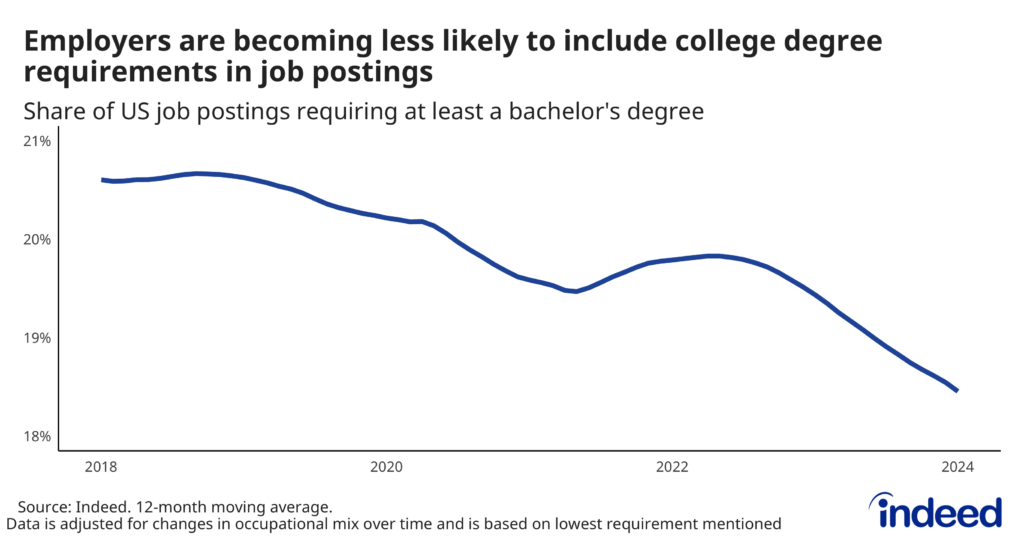
But while the long-term downward trend is clear, the uptick in bachelor’s and graduate degree requirements observed between summer 2020 and early 2022 — when the US labor market was tightening, with demand for workers exceeding worker supply — is interesting. One possible explanation is that the increase coincides with a rise in quits and a spike in pandemic-driven early retirements. A sudden exodus of experienced and educated workers may have prompted a flood of backfill postings from employers seeking a close match to those workers who had recently departed.
But after climbing to 19.8% in April 2022, the share of job postings requiring a college degree began falling again. While there are many possible explanations, it seems that the recent surge in public support for skills-first hiring and a shift in the types of workers being hired are the most probable drivers. Even after adjusting for changes in job title-mix over time, there has been a noticeable increase in companies looking to hire workers with less formal education to fill their vacancies.
Educational requirements are becoming less common in job postings
Analyzing educational requirements in job postings can be difficult, in part because employers often include multiple requirements in the same posting. Multiple requirements most commonly occur when an employer states a preference for a degree level (like a master’s degree) while expressing openness to a lower credential (i.e., a bachelor’s degree). This analysis used the lowest level of education mentioned in each posting to account for jobs with multiple requirements.
The share of jobs with no mention of any formal educational requirement grew from 48% in 2019 to 52% at the beginning of 2024. Over the same period, the share of postings requiring at least some kind of formal education has fallen across nearly every schooling level, with postings requiring a bachelor’s degree or above falling the most (2.6 percentage points). Declining shares at every level, paired with a rise in jobs without requirements, suggests that employers are gradually removing educational qualifications from postings.
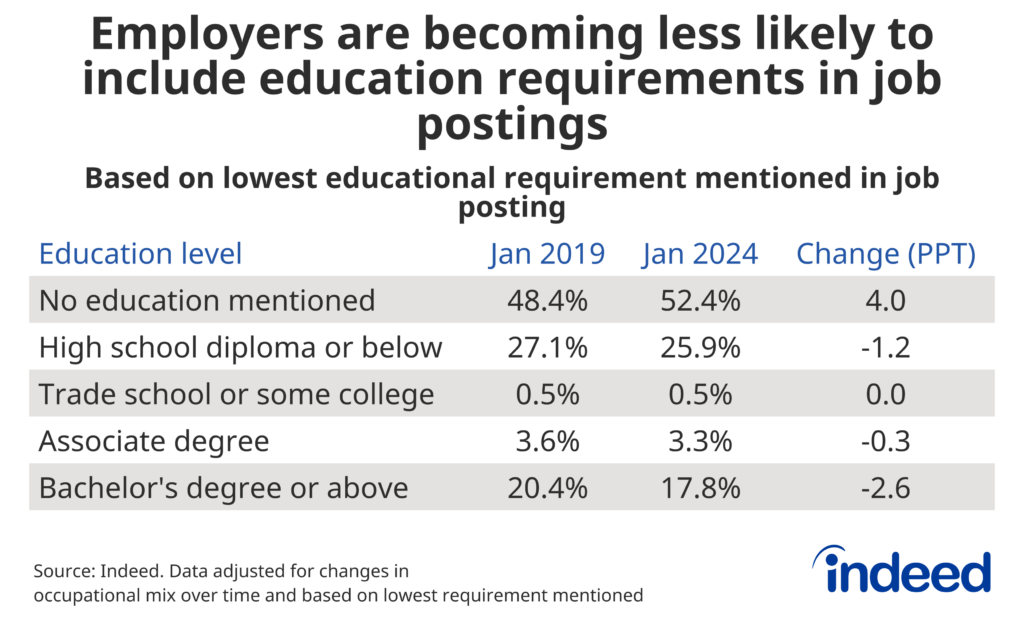
There are a few reasons why employers may forego formal educational requirements in job postings, the most obvious being simply that the job doesn’t require formal education. Beyond that, it appears that employers may omit educational requirements when they are assumed or implied. A good example is the physician and surgeon sector. We all know (hope?!) that our personal physicians completed extensive post-secondary medical school training and residencies, and it’s highly unlikely that someone without formal medical training would apply for a job as a physician or surgeon. Even so, roughly a third of job postings for physicians and surgeons only technically “require” a minimum of a bachelor’s degree. Similarly, employers will often focus on licenses or certifications that may require a formal degree or vocational training, but omit the formal education component in their posting. For example, a posting for an auto mechanic may require a certification from the National Institute for Automotive Service Excellence (ASE), without noting that getting that certification may require some formal vocational training to obtain.
Educational requirements are dropping in nearly every sector
Engineering and other STEM fields including mathematics and software development were among the sectors requiring the highest levels of education in January 2024. Industrial engineering topped the list, with 65.1% of postings explicitly requiring or preferring a bachelor’s degree or higher. In contrast, educational requirements were lowest in categories like driving (0.3% explicitly required or preferred a bachelor’s degree or higher), cleaning & sanitation (0.6%), and food preparation & service (1.3%).
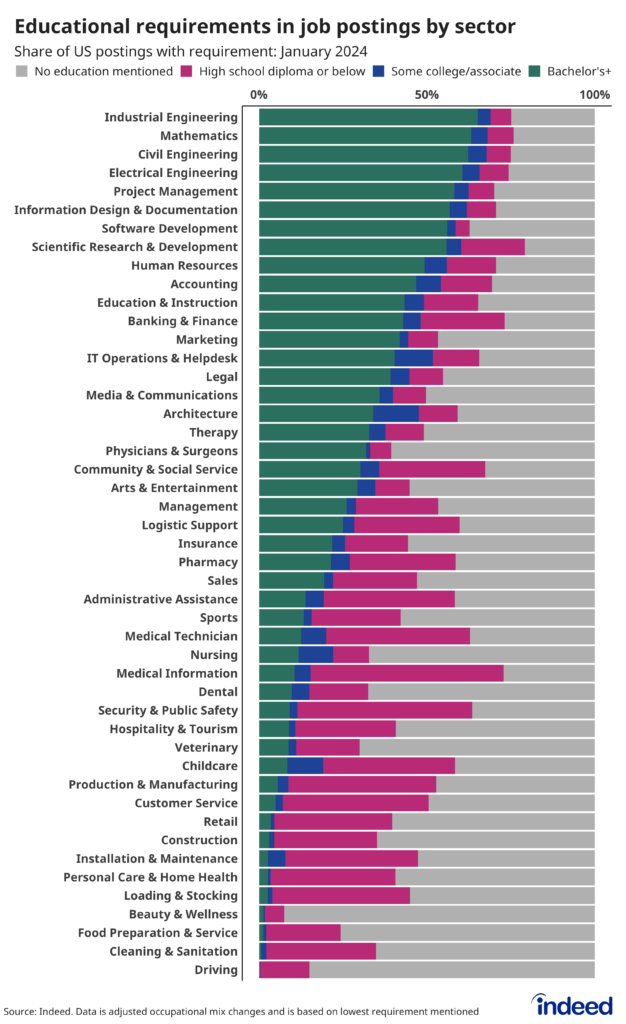
In the last five years, sectors with historically high educational requirements have seen the biggest changes. Project management jobs experienced the largest shift away from bachelor’s/graduate degree requirements — 58.1% of these postings required at least a bachelor’s degree in January 2024, down from 67.3% in January 2019, a drop of 9.2 percentage points. Information design & documentation and software development — both industries highly associated with the tech sector — followed, with drops of 9.0 and 8.4 percentage points, respectively, over the same period. This suggests that despite recent tech layoffs, companies are shifting hiring practices to attract the best workers in a resilient US labor market where only 35.7% of people have a bachelor’s degree or higher.
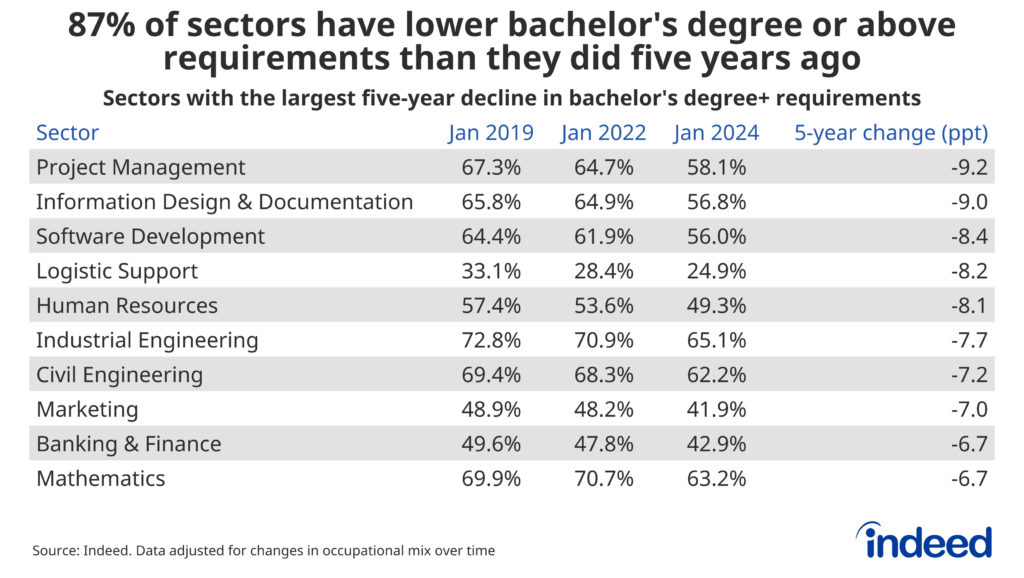
There have been some ups and downs in college degree requirements over the last five years. Between 2020 and 2022, educational requirements rose in 19 of the 47 occupational groups analyzed by Indeed. Knowledge work occupations including physicians & surgeons, architecture, and accounting comprised the majority of sectors with notably large increases during this period, further suggesting that employers may have been backfilling roles vacated by experienced/educated professionals who retired or otherwise resigned.
Many of those early pandemic increases subsequently fell back to previous levels — and then kept falling into January 2024. For example, the share of accounting jobs with college requirements rose by 3.4 percentage points between 2020 and 2022, then dropped by 8.0 percentage points in the last two years.
There are many possible reasons why educational requirements are fading from job postings. Determining which skills a job seeker has and how proficient they are at them has historically been difficult and expensive. So for many years, employers used the achievement of a formal degree as a proxy for judging a candidate’s ability to do the job at hand. However, developments in software as a service (SaaS) technologies and pre-employment testing have helped mitigate those challenges over the last decade. These technologies give employers the tools needed to adopt skills-first hiring approaches and expand their candidate pools beyond the limited number of Americans with college degrees, which is particularly vital in sectors where hiring challenges persist. Labor markets may not be as tight as they were a few years ago, but an aging US population and potentially shrinking worker pool in coming years will require employers and job seekers to look to the future.
The future of educational requirements in job postings
It’s hard to talk about skill requirements and the future of work without looking at artificial intelligence and GenAI. In previous research, Hiring Lab analyzed skills found in more than 55 million US job postings and evaluated GenAI’s ability to perform those skills, on a scale from “poor” to “fair” “good” and “excellent.” Jobs with a higher share of skills that could be done in a “good” or “excellent” manner by GenAI were determined to have a higher potential exposure to change from the tools. The analysis found that exposure to GenAI was generally highest for knowledge workers and in tech categories including software development, IT operations & helpdesk, and information design & documentation. Exposure was typically lowest in many hands-on, in-person roles — including driving, child care, and beauty & wellness — that generally require less formal education.
Comparing GenAI exposure to the share of jobs requiring a bachelor’s degree (or more) tells a similar story. Knowledge workers in sectors with higher education requirements face the greatest potential impact from these budding technologies. For example, mathematics had the second-highest educational requirement, with 63.2% of jobs requiring at least a 4-year degree. It also has the second-highest potential exposure to GenAI-driven change (93.6% of skills in the typical mathematics job posting can be done in a “good” or “excellent” manner by GenAI). Jobs in sectors including cleaning & sanitation and retail require less education and also face lower exposure to GenAI technologies.
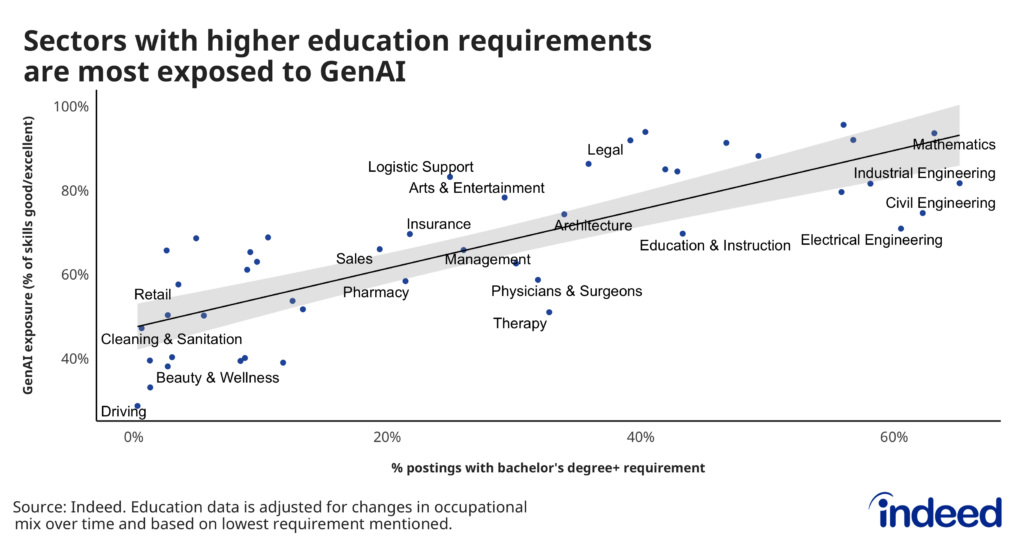
It’s unclear at the moment whether comparatively high or low potential exposure to GenAI technologies is positive or negative for knowledge workers, and what impact it will have on educational requirements going forward. On one hand, these technologies may be a boon for workers, leading to greater productivity and stronger employer demand. But it is also possible that GenAI may transform skill requirements and hiring practices, thus feeding into the trend of declining educational requirements and potentially unlocking new opportunities for the majority of adults without a college degree. Either way, embracing and developing skills, including learning and utilizing AI technologies, is likely to be important for all workers in the coming years, but may be even more vital for those whose jobs are primarily knowledge-based.
Conclusion
While educational requirements are unlikely to vanish from job postings, growing support of skills-first hiring approaches is a clear sign for workers to invest in skills now, regardless of their education level. In other words, even college-educated workers may have to think about reskilling more going forward. For employers, these trends suggest the need to reflect on current hiring requirements. By implementing skills-first hiring practices where it makes sense, employers can attract high-quality candidates, compete in tight labor market sectors, and mitigate some of the demographic headwinds facing labor supply.
Methodology
We tracked educational requirements by tallying US job postings on Indeed that mentioned one or more degree or training requirements in the job description as of February 6, 2024. Data is not adjusted for seasonality, but is adjusted for changes in job title-mix-by-weighting according to 2019 composition. In cases where multiple requirements were mentioned, the lowest was used. Analysis shows that the share of jobs with multiple requirements typically fluctuates between 10 – 12% in any given month.
Using the lowest requirement mentioned leads to lower shares across most education levels. For instance, in January 2024, about 22.4% of jobs on Indeed mentioned a bachelor’s, master’s, or doctoral degree preference or requirement, but some of those postings were open to lower education levels. When looking only at the lowest requirement mentioned, about 17.8% of jobs asked for a bachelor’s degree or higher. That 4-5 percentage point difference has remained consistent over time.
A full methodology of GenAI exposure data used in this piece can be found here.


